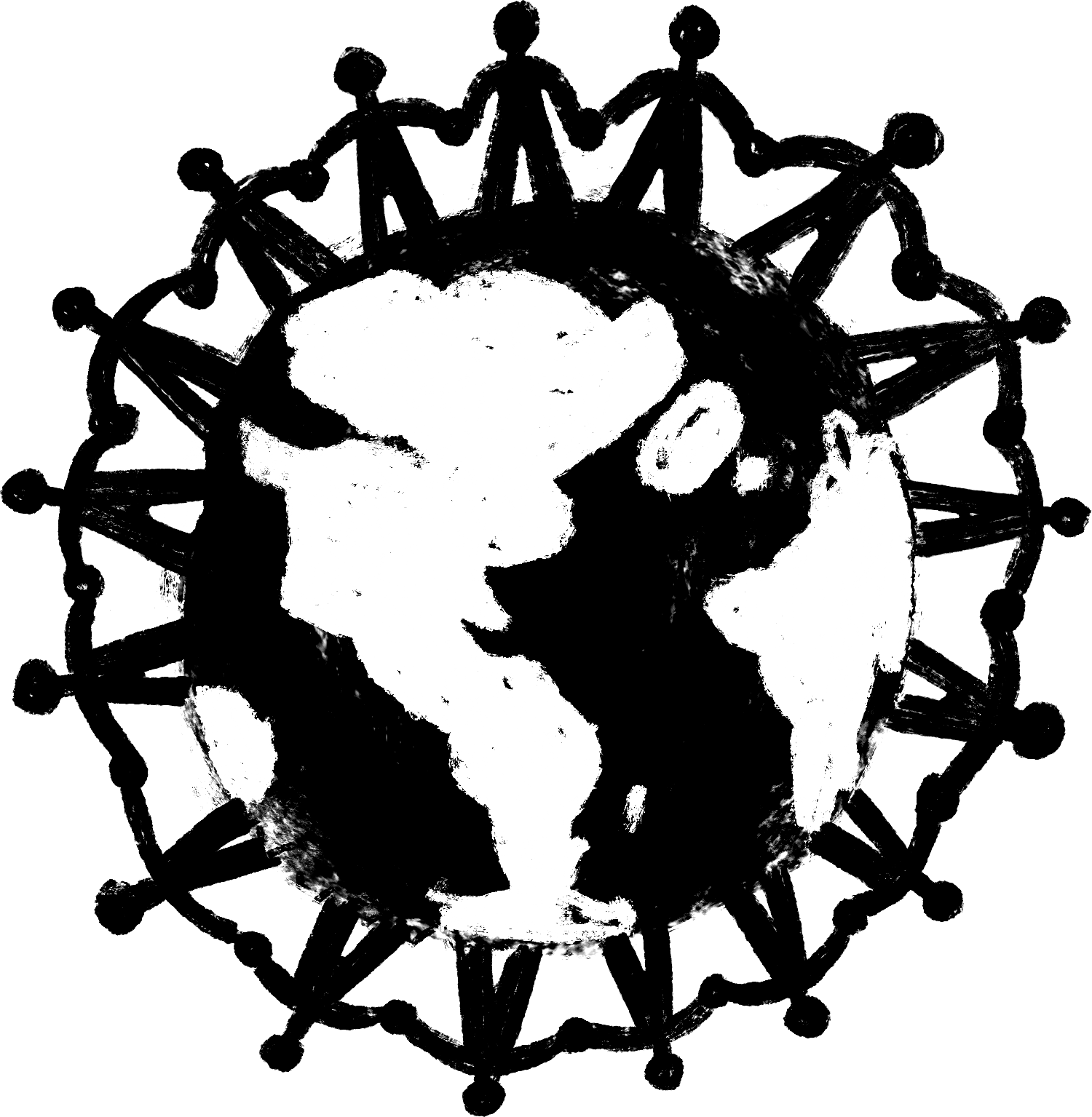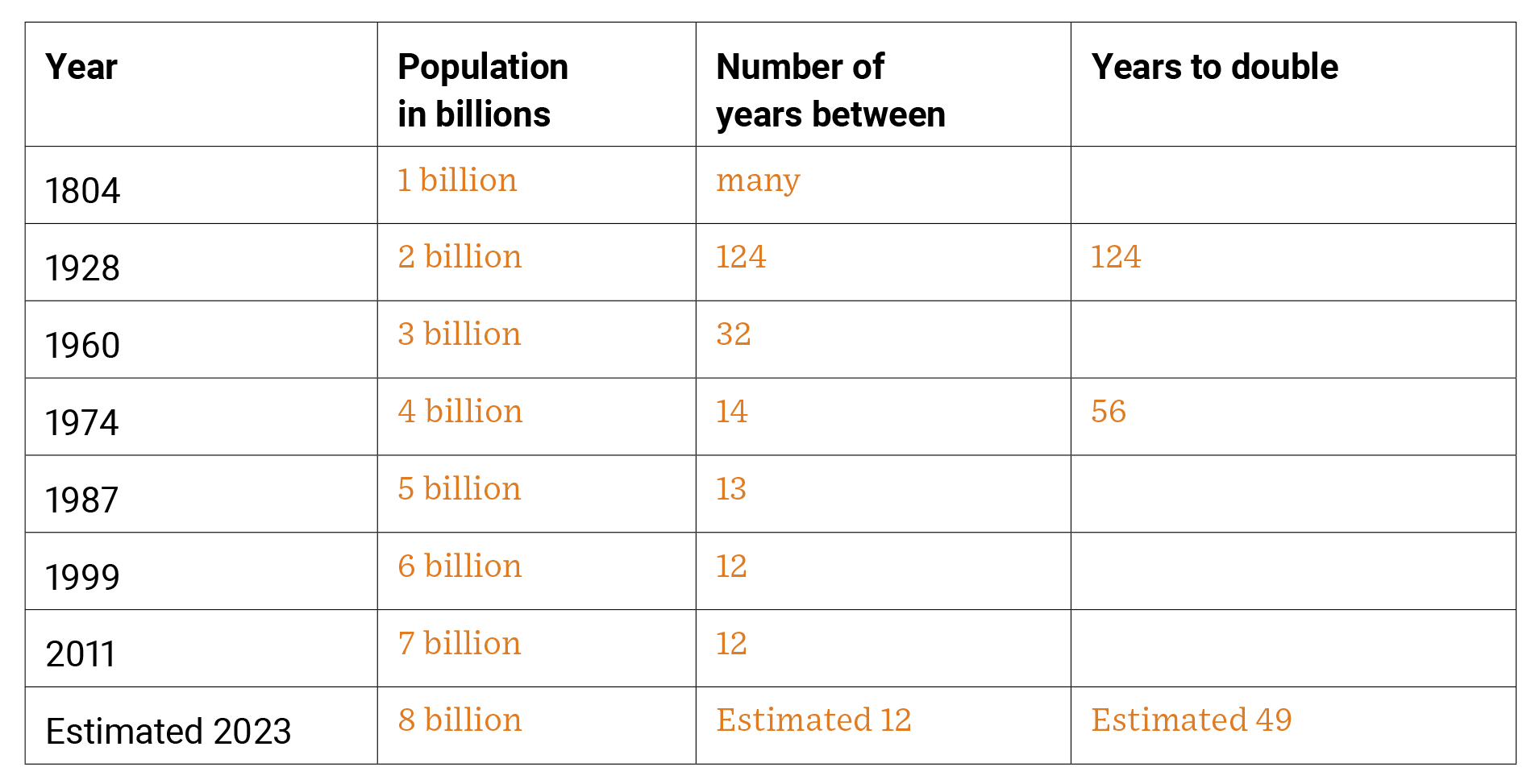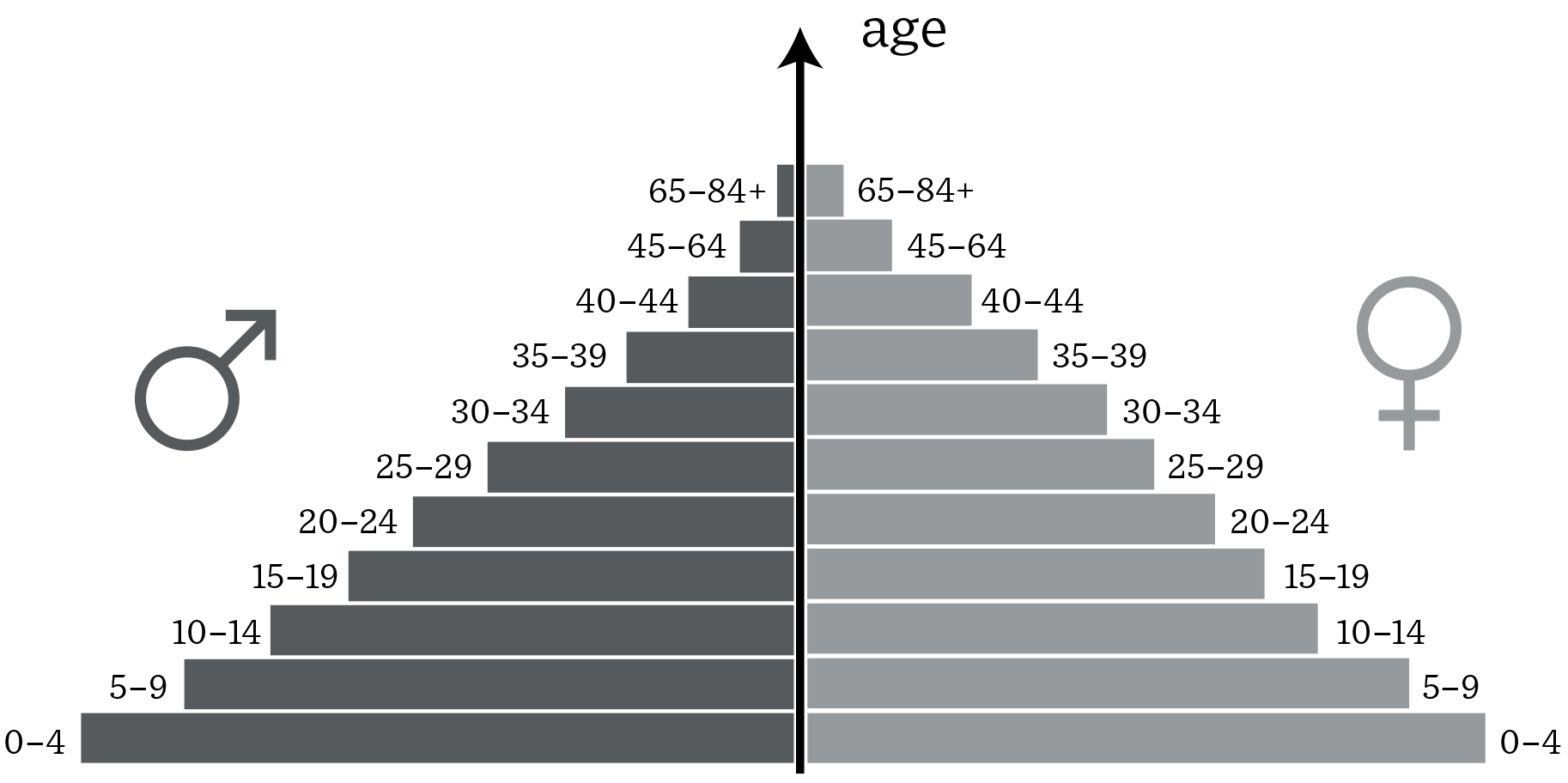Populations
Students evaluate the growth of human populations across time, analyze graphic data to make predictions about future population growth, research country statistics to evaluate demographic transition, and participate in a simulation of a village reliant on subsistence farming. Students begin to develop a sense for the Earth's carrying capacity and how humans have impacted it.

Background
Lesson Activities
Recommended Companion Resources
Credits
Author
Nourish the Future
Acknowledgements
This activity is an excerpt of the Populations unit created by Nourish the Future.
Standards
Texas Content Area Standards
-
Principles of Agriculture, Food, and Natural Resources: 130.2.c.1
The student demonstrates professional standards/employability skills as required by business and industry. The student is expected to:
- Principles of Agriculture, Food, and Natural Resources: 130.2.c.1.B: apply competencies related to resources, information, interpersonal skills, problem solving, critical thinking, and systems of operation in agriculture, food, and natural resources.
-
Principles of Agriculture, Food, and Natural Resources: 130.2.c.4
The student explains the historical, current, and future significance of the agriculture, food, and natural resources industry. The student is expected to:
- Principles of Agriculture, Food, and Natural Resources: 130.2.c.4.A: define the scope of agriculture.
- Principles of Agriculture, Food, and Natural Resources: 130.2.c.4.B: analyze the scope of agriculture, food, and natural resources and its effect upon society.
- Principles of Agriculture, Food, and Natural Resources: 130.2.c.4.C: evaluate significant historical and current agriculture, food, and natural resources developments.
- Principles of Agriculture, Food, and Natural Resources: 130.2.c.4.E: describe how emerging technologies and globalization impacts agriculture, food, and natural resources.
- Principles of Agriculture, Food, and Natural Resources: 130.2.c.4.F: compare and contrast issues impacting agriculture, food, and natural resources such as biotechnology, employment, safety, environment, and animal welfare issues.
- Principles, of Agriculture, Food, and Natural Resources: 130.2.c.4.D: identify potential future scenarios for agriculture, food, and natural resources systems, including global impacts.
-
Principles of Agriculture, Food, and Natural Resources: 130.2.c.6
The student demonstrates appropriate personal and communication skills. The student is expected to:
- Principles of Agriculture, Food, and Natural Resources: 130.2.c.6.A: demonstrate written and oral communication skills appropriate for formal and informal situations such as prepared and extemporaneous presentations.
- Principles of Agriculture, Food, and Natural Resources: 130.2.c.6.B: demonstrate effective listening skills appropriate for formal and informal situations.
-
World Geography Studies: 113.43.d.21
Social studies skills. The student applies critical-thinking skills to organize and use information acquired through established research methodologies from a variety of valid sources, including technology. The student is expected to:
- World Geography Studies: 113.43.d.21.F: formulate and communicate visually, orally, or in writing a claim supported by evidence and reasoning for an intended audience and purpose
-
Economics with Emphasis on the Free Enterprise System and Its Benefits: 113.31.d.21
Social studies skills. The student applies critical-thinking skills to organize and use information acquired through established research methodologies from a variety of valid sources, including technology. The student is expected to:
- Economics with Emphasis on the Free Enterprise System and Its Benefits: 113.31.d.21.F: formulate and communicate visually, orally, or in writing a claim supported by evidence and reasoning for an intended audience and purpose
-
English I: 110.36.c.1
Developing and sustaining foundational language skills: listening, speaking, discussion, and thinking--oral language. The student develops oral language through listening, speaking, and discussion.
- English I: 110.36.c.1.A: engage in meaningful and respectful discourse by listening actively, responding appropriately, and adjusting communication to audiences and purposes;
- English I: 110.36.c.1.B: follow and give complex oral instructions to perform specific tasks, answer questions, or solve problems and complex processes;
- English I: 110.36.c.1.D: participate collaboratively, building on the ideas of others, contributing relevant information, developing a plan for consensus building, and setting ground rules for decision making
-
English I: 110.36.c.4
Comprehension skills: listening, speaking, reading, writing, and thinking using multiple texts. The student uses metacognitive skills to both develop and deepen comprehension of increasingly complex texts.
- English I: 110.36.c.4.A: establish purpose for reading assigned and self-selected texts
- English I: 110.36.c.4.F: make inferences and use evidence to support understanding
- English I: 110.36.c.4.G: evaluate details read to determine key ideas
- English I: 110.36.c.4.I: monitor comprehension and make adjustments such as re-reading, using background knowledge, asking questions, and annotating when understanding breaks down
-
English I: 110.36.c.5
Response skills: listening, speaking, reading, writing, and thinking using multiple texts. The student responds to an increasingly challenging variety of sources that are read, heard, or viewed.
- English I: 110.36.c.5.B: write responses that demonstrate understanding of texts, including comparing texts within and across genres
- English I: 110.36.c.5.E: interact with sources in meaningful ways such as notetaking, annotating, freewriting, or illustrating
- English I: 110.36.c.5.F: respond using acquired content and academic vocabulary as appropriate
-
English II: 110.37.c.4
Comprehension skills: listening, speaking, reading, writing, and thinking using multiple texts. The student uses metacognitive skills to both develop and deepen comprehension of increasingly complex texts.
- English II: 110.37.c.4.A: establish purpose for reading assigned and self-selected texts
- English II: 110.37.c.4.F: make inferences and use evidence to support understanding
- English II: 110.37.c.4.G: evaluate details read to determine key ideas
- English II: 110.37.c.4.I: monitor comprehension and make adjustments such as re-reading, using background knowledge, asking questions, and annotating when understanding breaks down
-
English II: 110.37.c.1
Developing and sustaining foundation language skills: listening, speaking, discussion, and thinking--oral language. The student develops oral language through listening, speaking, and discussion.
- English II: 110.37.c.1.A: engage in meaningful and respectful discourse when evaluating the clarity and coherence of a speaker's message and critiquing the impact of a speaker's use of diction and syntax
- English II: 110.37.c.1.B: follow and give complex oral instructions to perform specific tasks, answer questions, or solve problems and complex processes
- English II: 110.37.c.1.D: participate collaboratively, building on the ideas of others, contributing relevant information, developing a plan for consensus building, and setting ground rules for decision making
-
English III: 110.38.c.1
Developing and sustaining foundational language skills: listening, speaking, discussion, and thinking--oral language. The student develops oral language through listening, speaking, and discussion.
- English III: 110.38.c.1.A: engage in meaningful and respectful discourse when evaluating the clarity and coherence of a speaker's message and critiquing the impact of a speaker's use of diction and syntax
- English III: 110.38.c.1.B: follow and give complex instructions, clarify meaning by asking pertinent questions, and respond appropriately
- English III: 110.38.c.1.D: participate collaboratively, offering ideas or judgments that are purposeful in moving the team toward goals, asking relevant and insightful questions, tolerating a range of positions and ambiguity in decision making, and evaluating the work of the group based on agreed-upon criteria
-
English III: 110.38.c.4
Comprehension skills: listening, speaking, reading, writing, and thinking using multiple texts. The student uses metacognitive skills to both develop and deepen comprehension of increasingly complex texts.
- English III: 110.38.c.4.A: establish purpose for reading assigned and self-selected texts
- English III: 110.38.c.4.F: make inferences and use evidence to support understanding
- English III: 110.38.c.4.G: evaluate details read to understand key ideas
- English III: 110.38.c.4.I: monitor comprehension and make adjustments such as re-reading, using background knowledge, asking questions, annotating, and using outside sources when understanding breaks down
-
English III: 110.38.c.5
Response skills: listening, speaking, reading, writing, and thinking using multiple texts. The student responds to an increasingly challenging variety of sources that are read, heard, or viewed.
- English III: 110.38.c.5.B: write responses that demonstrate analysis of texts, including comparing texts within and across genres
- English III: 110.38.c.5.E: interact with sources in meaningful ways such as notetaking, annotating, freewriting, or illustrating
- English III: 110.38.c.5.F: respond using acquired content and academic vocabulary as appropriate
-
English II: 110.37.c.5
Response skills: listening, speaking, reading, writing, and thinking using multiple texts. The student responds to an increasingly challenging variety of sources that are read, heard, or viewed.
- English II: 110.37.c.5.B: write responses that demonstrate understanding of texts, including comparing texts within and across genres
- English II: 110.37.c.5.E: interact with sources in meaningful ways such as notetaking, annotating, freewriting, or illustrating
- English II: 110.37.c.5.F: respond using acquired content and academic vocabulary as appropriate
-
English IV: 110.39.c.1
Developing and sustaining foundational language skills: listening, speaking, discussion, and thinking--oral language. The student develops oral language through listening, speaking, and discussion.
- English IV: 110.39.c.1.A: engage in meaningful and respectful discourse when evaluating the clarity and coherence of a speaker's message and critiquing the impact of a speaker's use of diction, syntax, and rhetorical strategies
- English IV: 110.39.c.1.B: follow and give complex instructions, clarify meaning by asking pertinent questions, and respond appropriately
- English IV: 110.39.c.1.D: participate collaboratively, offering ideas or judgments that are purposeful in moving the team toward goals, asking relevant and insightful questions, tolerating a range of positions and ambiguity in decision making, and evaluating the work of the group based on agreed-upon criteria
-
English IV: 110.39.c.4
Comprehension skills: listening, speaking, reading, writing, and thinking using multiple texts. The student uses metacognitive skills to both develop and deepen comprehension of increasingly complex texts.
- English IV: 110.39.c.4.A: establish purpose for reading assigned and self-selected texts
- English IV: 110.39.c.4.F: make inferences and use evidence to support understanding
- English IV: 110.39.c.4.G: evaluate details read to analyze key ideas
- English IV: 110.39.c.4.I: monitor comprehension and make adjustments such as re-reading, using background knowledge, asking questions, annotating, and using outside sources when understanding breaks down
-
English IV: 110.39.c.5
Response skills: listening, speaking, reading, writing, and thinking using multiple texts. The student responds to an increasingly challenging variety of sources that are read, heard, or viewed.
- English IV: 110.39.c.5.B: write responses that demonstrate analysis of texts, including comparing texts within and across genres
- English IV: 110.39.c.5.E: interact with sources in meaningful ways such as notetaking, annotating, freewriting, or illustrating
- English IV: 110.39.c.5.F: respond using acquired content and academic vocabulary as appropriate
-
Algebra I: 111.39.c.1
Mathematical process standards. The student uses mathematical processes to acquire and demonstrate mathematical understanding.
- Algebra I: 111.39.c.1.A: apply mathematics to problems arising in everyday life, society, and the workplace
- Algebra I: 111.39.c.1.B: use a problem-solving model that incorporates analyzing given information, formulating a plan or strategy, determining a solution, justifying the solution, and evaluating the problem-solving process and the reasonableness of the solution
- Algebra I: 111.39.c.1.E: create and use representations to organize, record, and communicate mathematical ideas
-
Statistics: 111.47.c.1
Mathematical process standards. The student uses mathematical processes to acquire and demonstrate mathematical understanding.
- Statistics: 111.47.c.1.A: apply mathematics to problems arising in everyday life, society, and the workplace
- Statistics: 111.47.c.1.B: use a problem-solving model that incorporates analyzing given information, formulating a plan or strategy, determining a solution, justifying the solution, and evaluating the problem-solving process and the reasonableness of the solution
- Statistics: 111.47.c.1.C: select tools, including real objects, manipulatives, paper and pencil, and technology as appropriate, and techniques, including mental math, estimation, and number sense as appropriate, to solve problems
- Statistics: 111.47.c.1.D: communicate mathematical ideas, reasoning, and their implications using multiple representations, including symbols, diagrams, graphs, and language as appropriate
-
Statistics: 111.47.c.5
Probability and random variables. The student applies the mathematical process standards to connect probability and statistics.
- Statistics: 111.47.c.5.A: determine probabilities, including the use of a two-way table
-
Mathematical Models with Applications: 111.43.c.9
Mathematical modeling in social sciences. The student applies mathematical processes and mathematical models to analyze data as it applies to social sciences.
- Mathematical Models with Applications: 111.43.c.9.A: interpret information from various graphs, including line graphs, bar graphs, circle graphs, histograms, scatterplots, dot plots, stem-and-leaf plots, and box and whisker plots, to draw conclusions from the data and determine the strengths and weaknesses of conclusions
-
Advanced Quantitative Reasoning: 111.44.c.1
Mathematical process standards. The student uses mathematical processes to acquire and demonstrate mathematical understanding.
- Advanced Quantitative Reasoning: 111.44.c.1.A: apply mathematics to problems arising in everyday life, society, and the workplace
- Advanced Quantitative Reasoning: 111.44.c.1.B: use a problem-solving model that incorporates analyzing given information, formulating a plan or strategy, determining a solution, justifying the solution, and evaluating the problem-solving process and the reasonableness of the solution
- Advanced Quantitative Reasoning: 111.44.c.1.E: create and use representations to organize, record, and communicate mathematical ideas
-
World History Studies: 113.42.d.28
Social studies skills. The student understands how historians use historiography to interpret the past and applies critical-thinking skills to organize and use information acquired from a variety of valid sources, including technology. The student is expected to:
- World History Studies: 113.42.d.28.F: formulate and communicate visually, orally, or in writing a claim supported by evidence and reasoning for an intended audience and purpose
-
Environmental Systems: 112.50.c.1
Scientific and engineering practices. The student, for at least 40% of instructional time, asks questions, identifies problems, and plans and safely conducts classroom, laboratory, and field investigations to explain phenomena or design solutions using appropriate tools and models. The student is expected to:
- Environmental Systems: 112.50.c.1.A: ask questions and define problems based on observations or information from text, phenomena, models, or investigations
- Environmental Systems: 112.50.c.1.E: collect quantitative data using the International System of Units (SI) and qualitative data as evidence;
- Environmental Systems: 112.50.c.1.F: organize quantitative and qualitative data using probeware, spreadsheets, lab notebooks or journals, models, diagrams, graphs paper, computers, or cellphone applications
-
Environmental Systems: 112.50.c.5
Science concepts. The student knows the relationships of biotic and abiotic factors within habitats, ecosystems, and biomes. The student is expected to:
- Environmental Systems: 112.50.c.5.G: predict changes that may occur in an ecosystem if genetic diversity is increased or decreased
-
Environmental Systems: 112.50.c.6
Science concepts. The student knows the interrelationships among the resources within the local environmental system. The student is expected to:
- Environmental Systems: 112.50.c.6.D: identify how changes in limiting resources such as water, food, and energy affect local ecosystems
- Environmental Systems: 112.50.c.6.E: analyze and evaluate the economic significance and interdependence of resources within the local environmental system
- Environmental Systems: 112.50.c.6.F: evaluate the impact of waste management methods such as reduction, reuse, recycling, upcycling, and composting on resource availability in the local environment
-
Environmental Systems: 112.50.c.8
Science concepts. The student knows the relationship between carrying capacity and changes in populations and ecosystems. The student is expected to:
- Environmental Systems: 112.50.c.8.A: compare exponential and logistical population growth using graphical representations
- Environmental Systems: 112.50.c.8.B: identify factors that may alter carrying capacity such as disease; natural disaster; available food, water, and livable space; habitat fragmentation; and periodic changes in weather
- Environmental Systems: 112.50.c.8.C: calculate changes in population size in ecosystems
- Environmental Systems: 112.50.c.8.D: analyze and make predictions about the impact on populations of geographic locales due to diseases, birth and death rates, urbanization, and natural events such as migration and seasonal changes
-
Environmental Systems: 112.50.c.12
Science concepts. The student understands how ethics and economic priorities influence environmental decisions. The student is expected to:
- Environmental Systems: 112.50.c.12.A: evaluate cost-benefit trade-offs of commercial activities such as municipal development, food production, deforestation, over-harvesting, mining, and use of renewable and non-renewable energy sources;
- Environmental Systems: 112.50.c.12.B: evaluate the economic impacts of individual actions on the environment such as overbuilding, habitat destruction, poaching, and improper waste disposal
- Environmental Systems: 112.50.c.12.C: analyze how ethical beliefs influence environmental scientific and engineering practices such as methods for food production, water distribution, energy production, and the extraction of minerals
-
Earth Systems Science: 112.49.c.1
Scientific and engineering practices. The student, for at least 40% of instructional time, asks questions, identifies problems, and plans and safely conducts classroom, laboratory, and field investigations to explain phenomena or design solutions using appropriate tools and models. The student is expected to:
- Earth Systems Science: 112.49.c.1.A: ask questions and define problems based on observations or information from text, phenomena, models, or investigations
- Earth Systems Science: 112.49.c.1.E: collect quantitative data using the International System of Units (SI) and qualitative data as evidence
- Earth Systems Science: 112.49.c.1.F: organize quantitative and qualitative data using scatter plots, line graphs, bar graphs, charts, data tables, digital tools, diagrams, scientific drawings, and student-prepared models
-
Earth Systems Science: 112.49.c.12
Science concepts. The student understands how Earth's systems affect and are affected by human activities, including resource use and management. The student is expected to:
- Earth Systems Science: 112.49.c.12.A: evaluate the impact on humans of natural changes in Earth's systems such as earthquakes, tsunamis, and volcanic eruptions
- Earth Systems Science: 112.49.c.12.C: analyze the natural and anthropogenic factors that affect the severity and frequency of extreme weather events and the hazards associated with these events
- Earth Systems Science: 112.49.c.12.D: analyze recent global ocean temperature data to predict the consequences of changing ocean temperature on evaporation, sea level, algal growth, coral bleaching, and biodiversity
-
Earth Systems Science: 112.49.c.13
Science concepts. The student explores global policies and careers related to the life cycles of Earth's resources. The student is expected to:
- Earth Systems Science: 112.49.c.13.A: analyze the policies related to resources from discovery to disposal, including economics, health, technological advances, resource type, concentration and location, waste disposal and recycling, mitigation efforts, and environmental impacts
 According to most estimates, there will be over 9.5 billion people on the planet in 2050. Many experts suggest that growers will have to produce more food in the next 50 years than has been grown in the past 10,000, which would mean doubling current production on the same amount of land. Yield increases have begun to slow (
According to most estimates, there will be over 9.5 billion people on the planet in 2050. Many experts suggest that growers will have to produce more food in the next 50 years than has been grown in the past 10,000, which would mean doubling current production on the same amount of land. Yield increases have begun to slow (

